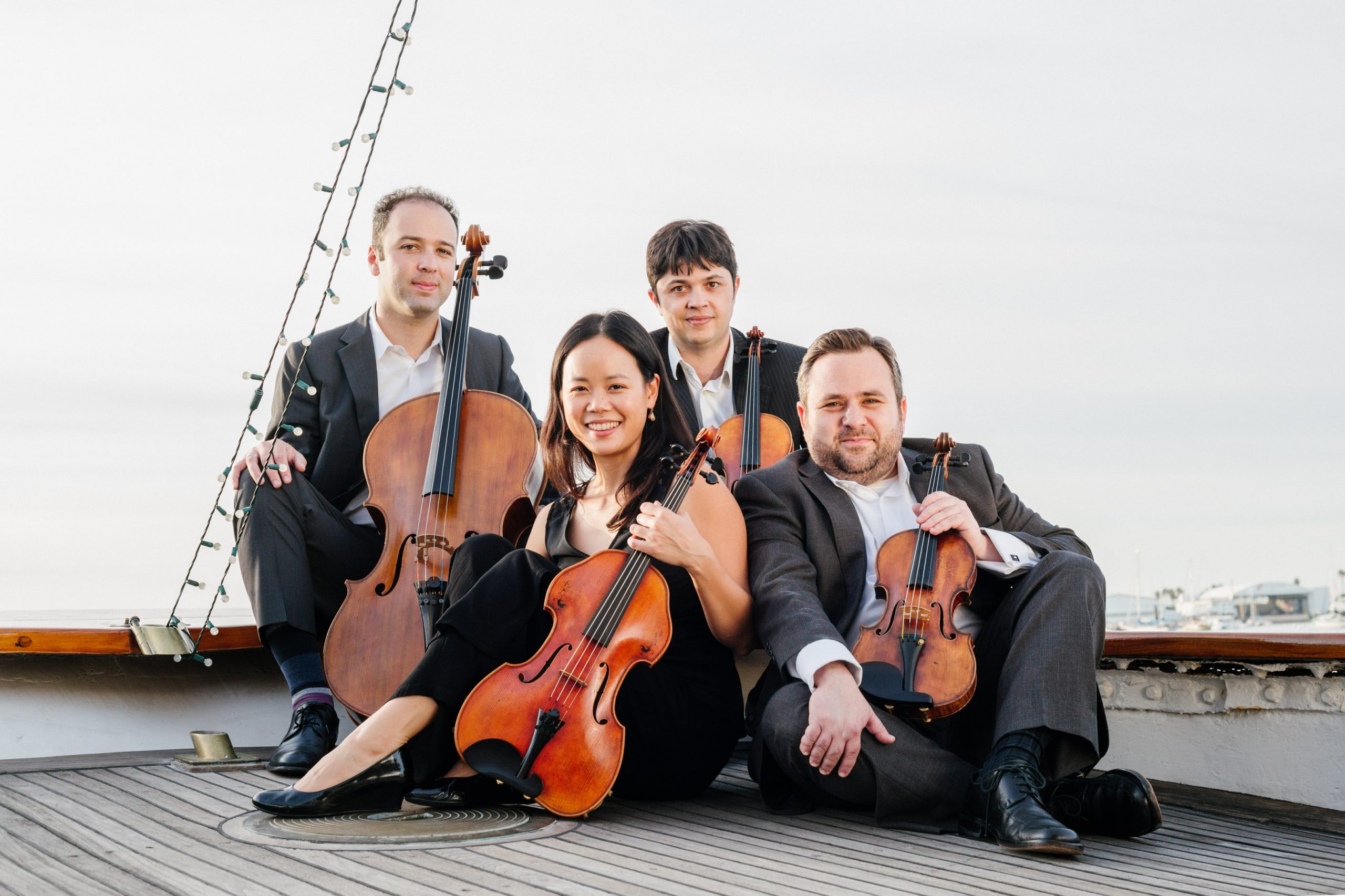The Hausmann Quartet Brilliantly Surrounds Haydn with Ned Rorem and Maurice Ravel
Derek Katz, the Hausmann Quartet’s resident musicologist commentator, told Sunday’s concert audience that San Diego’s intrepid chamber ensemble would complete two-thirds of Haydn’s 60 string quartets with Sunday afternoon’s performance of his Quartet in F-sharp Minor, Op. 50, No. 4. Aptly titled the Haydn Voyages: Music at the Maritime, Hausmann’s multi-year musical project to perform all of Haydn’s string quartets has developed a loyal following in performances at the Maritime Museum of San Diego’s Berkeley, a former San Francisco Bay Area ferry permanently moored on San Diego Bay.

Hausmann Quartet: (from left) Alex Greenbaum, Angela Choong, Isaac Allen, Bram Goldstein [photo (c.) Samantha Zauscher]
Known for his sophisticated art songs and the literary panache of his tell-all books on the musical life of Paris in the years after World War II, Rorem’s impressive late String Quartet No. 4 reveals his inner Elliott Carter in terms of structural complexity and textural density, without forsaking his unique melodic gift that has made his art songs so rewarding. Unlike the traditional four-movement string quartet, Rorem’s Quartet No. 4 is organized in ten movements, each defined by a the composer’s intention for the movement’s character, e.g. “Infinitely tender,” “Massive,” “Wistful,” and “Like the wind.”
Originally, Rorem had linked each movement to a Pablo Picasso painting, and a bit of online sleuthing can turn up a catalogue of possible artistic correlations to each movement, although the composer removed the Picasso titles before the string quartet was published and given its first performance in 1995 by the Emerson Quartet, for which the work was commissioned. Hausmann cleverly used a portion of Picasso’s painting “Young Acrobat on a Ball,” the painting that inspired the string quartet’s third movement, to grace the cover of Sunday’s program.
The various musical moods of Quartet No. 4 reflect the breadth of Rorem’s identity. We hear compelling instrumental arias: a haunting viola solo that opens the fourth movement, played with soulful depth by Angela Choong; second violinist Bram Goldstein’s ardent but quiet solos in the tenth movement, as well as angular, athletic themes such as the bright cello solo that colors the eighth movement, played with customary elan by Alex Greenbaum. The explosive seventh movement is charged with whirring figures and sharp pizzicatos from all the instruments that builds its bold dramatic character. In the sixth movement—aptly titled “Massive”—Rorem crafts rich, harmonically dense, slowly moving chord progressions that his early mentor Virgil Thomson would have surely savored.
Hausmann’s elegant account of Ravel’s Quartet in F Major—displaying a warm, glowing sonority as well as eloquent phrasing throughout—clearly communicated Ravel’s deft juxtaposition of formality and sensuality in this work. I was taken by the players’ ebullient pizzicato drive in the brilliant second movement, marked “Assez vif et très rythmé,” as well as the strings’ vibrant dynamic contrasts in the lush opening movement.
The moment the Hausmann Quartet launches into a Haydn string quartet, their sound takes on a special character, an effusive, ingratiating ensemble that these players have developed through their immersion in Haydn’s rich string quartet canon. In the opening movement of his Quartet in F-sharp Minor, Op. 50, No. 4, I particularly enjoyed the spirited camaraderie of the interplay between first violinist Isaac Allen and cellist Alex Greenbaum, as well as the ensemble’s bracing but lithe allegros. This F-sharp Minor string quartet spends an unusual amount of time in the major mode, however, and it climaxes with a concise but robust, good-natured fugue.
This concert was presented by the Hausmann Quartet on Sunday, September 17, 2023, at the Maritime Museum of San Diego on San Diego Bay in downtown San Diego. The next Haydn Voyage concert is scheduled for November 19, 2023, in the same venue.

Ken Herman, a classically trained pianist and organist, has covered music for the San Diego Union, the Los Angeles Times’ San Diego Edition, and for sandiego.com. He has won numerous awards, including first place for Live Performance and Opera Reviews in the 2017, the 2018, and the 2019 Excellence in Journalism Awards competition held by the San Diego Press Club. A Chicago native, he came to San Diego to pursue a graduate degree and stayed.Read more…
